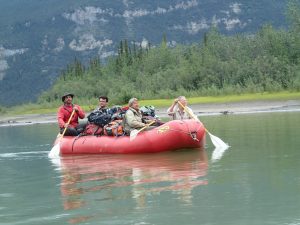Current and Recent Funding: Return to my home page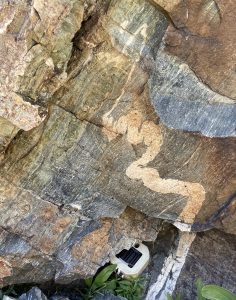
Structural, metamorphic, and thermal evolution of the Brooks Range (Alaska) metamorphic belts: implications for formation-exhumation of high-pressure rocks and Arctic tectonic evolution. National Science Foundation; Project dates: 2021-2023.
Ductile strain in the footwall of a metamorphic core complex: A field example to test models for dynamics, timescales, and controls of mid-crustal flow. National Science Foundation; Project dates: 2017-present.
Geologic maps and sections of the Challis volcanics in the hangingwall of the Pioneer Mountains metamorphic core complex, Idaho. USGS EdMap; Project dates: 2018-2019.
Geology and geochronology of the Ernie Lake area, central Brooks Range, Alaska. USGS EdMap; Project dates: 2017-2018.
Current & Recent students: Carolina Ortiz-Guerrero (current Ph.D.), Megan Borel (current Ph.D), Laura Mulrooney (current undergraduate); Jason Titus (M.Sc. 2020), Ryan Wilhelmi (Ph.D. 2020, co-supervisor), Fiona Pedrick (B.A. 2020, Occidental College)
Current Projects by Field Area
Brooks Range, northern Alaska – I am currently looking for new graduate students for this project
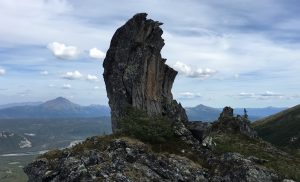 The goals of this new project are to (1) test models for the formation and exhumation of high-pressure rocks, (2) develop a more comprehensive understanding of island-arc collision zones, and (3) investigate the relationships between the tectonics of the Brooks Range (and along-strike equivalents) and opening od the Canada Basin (Arctic Ocean).This project involves extensive field mapping integrated with structural analysis, metamorphic P-T work, Lu-Hf garnet dating, U-Pb geochronology, and 40Ar/39Ar thermochronology.
The goals of this new project are to (1) test models for the formation and exhumation of high-pressure rocks, (2) develop a more comprehensive understanding of island-arc collision zones, and (3) investigate the relationships between the tectonics of the Brooks Range (and along-strike equivalents) and opening od the Canada Basin (Arctic Ocean).This project involves extensive field mapping integrated with structural analysis, metamorphic P-T work, Lu-Hf garnet dating, U-Pb geochronology, and 40Ar/39Ar thermochronology.
Other Brooks Range research: The Ernie Lake region contains the oldest rocks in the Brooks Range (~970 Ma granitic orthogneiss) and therefore provide a rare opportunity to observe basement rocks to the Cretaceous Brooks Range orogen. Furthermore, previous mapping has suggested that the orthogneiss and host rocks may be overlain by Mississippian clastic rocks along a prominent unconformity. Our work has included detailed mapping, U/Pb detrital zircon geochronology, and geochronology of additional granitic orthogneiss bodies. Our goals are to (1) test the idea of a sub-Mississippian unconformity to better constrain palinspastic restorations of the pre-orogenic continental margin and better understand the development of the Cretaceous orogen, and (2) use the basement rocks to better constrain the location of these rocks in the Arctic realm at various times prior to Cretaceous opening of the Canada Basin.
Pioneer Metamorphic core Complex, south-central Idaho
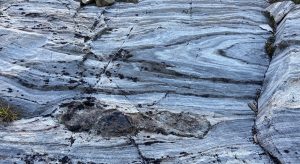 The overarching goal of this project is to decipher the deformational history of the footwall of the core complex. This work has several subprojects.
The overarching goal of this project is to decipher the deformational history of the footwall of the core complex. This work has several subprojects.
(1) Test the idea that an abrupt downward transition in lineation orientations represents a zone of isostatically induced decoupled flow into the core complex. This type of decoupled flow is depicted in many models for core complex formation, yet the process and resulting features remains poorly documented. This work involves detailed field mapping and structural analysis of the lineation transition zone, as well as establishing the timing of strain at the two levels by dating deformed and undeformed dikes that are widespread. We are also documenting P-T histories of the rocks across the transition zone to establish the vertical motions and conditions of decoupling via metamorphic.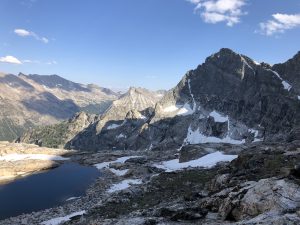
(2) Establish the timing and controls of strain localization across all levels of the footwall. Ductile fabrics are pervasive in the footwall, but controls such lithology and magmatic heat have led to a complex strain evolution.
(3) Establish the timing and kinematics of footwall faults to fully understand the structural development of the footwall and provide a framework for interpreting the mechanical significance for enigmatic low-angle strike-slip faults in the adjacent hangingwall.
Miocene to Recent structural and topographic evolution of the Pioneer-Boulder-Boise-Sawtooth Mountains, ID
This research involves the study of uplift/exhumation patterns in the Pioneer, Boulder, Boise, and Sawtooth Mountains through the application of (U-Th)/He and fission-track thermochronology. The aim of this work is to understand the interrelationships between faulting, thermal uplift related to the Yellowstone hotspot, and downwarping of the eastern Snake River Plain, as well as the influence of these processes on the topographic evolution of the region.
Montana: Highland Mountains dome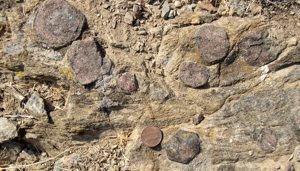
The main goals of this study are (1) to investigate the processes of mid-crustal dome formation and (2) document the kinematics associated with Paleoproterozoic orogenesis along the Great Falls tectonic zone during the “Big Sky orogeny”. This work mainly involves detailed structural analysis and field mapping, integrated with U-Pb geochronology, and 40Ar/39Ar thermochronology. The project is part of a larger project with David Foster and Paul Mueller addressing the Precambrian crustal evolution of the southwestern Laurentian margin.

